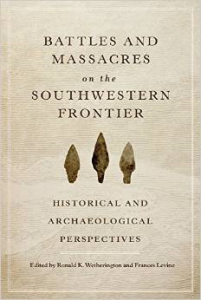Book Review: Battles and Massacres on the Southwestern Frontier
Here is a book review I wrote for the Overland Journal, the quarterly magazine of the Oregon California Trails Association. I am Vice President of the Colorado Cherokee Trail chapter of the organization. The review is the reason for a delay in getting a post up. I had trouble with one section of the book which has poor graphics and some errors, although it is important research. It took weeks of ranting at people about it until I was able to calm down and include a short paragraph pointing out the problems. Maybe next time I won’t get so personally involved in someone else’s work.
BATTLES AND MASSACRES ON THE SOUTHWESTERN FRONTIER: HISTORICAL AND ARCHAEOLOGICAL PERSPECTIVES
Edited by Ronald K. Weatherington and Frances Levine
Norman: University of Oklahoma Press, 2014
248 pp., photos, maps, illustrations, extensive references, index
Paper, 5” x 8”
 Battles and Massacres is a book that looks at several battles or massacres in the mid-nineteenth century from the perspectives of historians and archaeologists. This is important because the historical record is usually written by one side of the conflict. The archaeological record does not engage in cover ups, obfuscation, or have a political agenda.
Battles and Massacres is a book that looks at several battles or massacres in the mid-nineteenth century from the perspectives of historians and archaeologists. This is important because the historical record is usually written by one side of the conflict. The archaeological record does not engage in cover ups, obfuscation, or have a political agenda.
The book examines four nineteenth century events in the American southwest involving Native Americans and Euro-Americans and the conflicts rising from westward expansion. The encounters are the Battle of Cieneguilla in New Mexico, Adobe Walls in Texas, the Sand Creek Massacre in Colorado, and the Mountain Meadows Massacre in Utah.
The first three were direct conflicts involving Indians and soldiers or buffalo hunters. Mountain Meadows was between Mormons of Southern Utah and a train of emigrants headed to California. Some Paiutes acted with the Mormon militia.
This book is important in illustrating how modern archaeological methods can apply objective information to a historical record that can be essentially accurate, as at Adobe Walls, or what amounted to a cover-up at Cieneguilla.
Adobe Walls was a trading post in the Texas Panhandle occupied by a number of hide hunters engaging in killing as many Bison as possible for profit, while destroying the Native Americans livelihood. A large group of Cheyenne warriors, believing that their medicine would protect them from the hide hunter’s bullets, attacked twenty-eight men and one woman. The medicine did not work. The big buffalo rifles were able to outrange the attacker’s weapons and many Indians were killed. Three of the defenders were wounded.
The archaeological data showed that the majority of the Indian weapons were relatively short range rifles like the Henry and Spencer carbines, easily outranged by the big Sharps rifles of the hide hunters. There were bullets from muzzleloaders and steel arrow points as well.
The recent archaeological investigations at Sand Creek have established the actual location of the massacre and validated the conclusion that there was a slaughter of people who were not able to effectively defend themselves, believing that they were under the protection of the U.S. Government. Almost all of the recovered artifacts were from Army weapons. The massacre was the result of John Chivington deciding that the Indians should all be killed.
Mountain Meadows is different, mostly Euro-Americans killing other Euro-Americans. The essay in this book is unusual in that it comes from a Mormon Church historian and places culpability on the Southern Utah Mormon leadership for the massacre. Given the tensions prevailing between the Utah Mormons and the U. S. Government, it was understandable there would be some conflict between the Mormons and a wagon train from Arkansas, but how it escalated into the slaughter of all the migrants over seven years old remains obscure.
Archaeological investigation at Mountain Meadows is difficult because of repeated disturbances over 150 years and the resistance of the Utah political leadership. A study that was halted by the then Utah Governor, a descendant of one of the attackers, did provide forensic information that reinforced the conclusion that the emigrants were disarmed and slaughtered.
The studies of the battle of Cieneguilla in 1854 illustrate how an archaeological survey can refute the historical accounts dating from the time of the battle. Of sixty troopers of the First Dragoons led into battle by Lt. John Davidson, twenty four were killed and twenty three wounded by about 100 Jicarilla Apaches.
The official report by Lt. Davidson is a story of a gallant attack by Dragoons against a superior force. In fact, the troopers, after leaving their horses in a canyon bottom, attacked uphill and were outflanked and hunted down by the Apaches as they tried to retreat. A Lt. Bell attempted to correct the report, but never received a hearing and was subsequently killed in action.
While the Cieneguilla study is important, there are some flaws. The archeology is well done, the maps are not, making it difficult to visualize the entire battlefield and the movements of the combatants. In addition, both essays explore the Battle of Cieneguilla, but fail to mention that what was Cieneguilla in 1854 is now Pilar, not far south of Taos.
The real tragedy of Cieneguilla is that the Apaches were then hunted down, starved, and sent to a reservation.
Overall, the book does an effective job of showing how history and archaeology can come together to provide a more accurate picture of events that occurred more than 150 years ago.